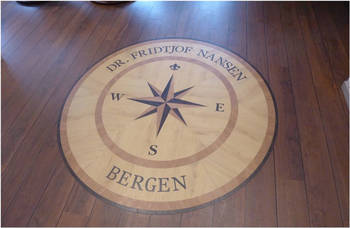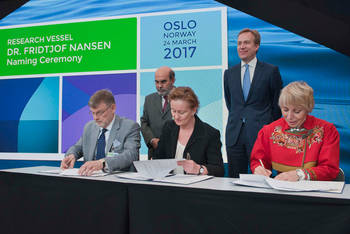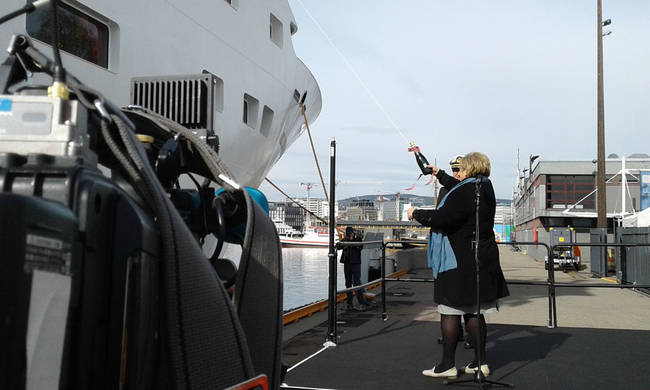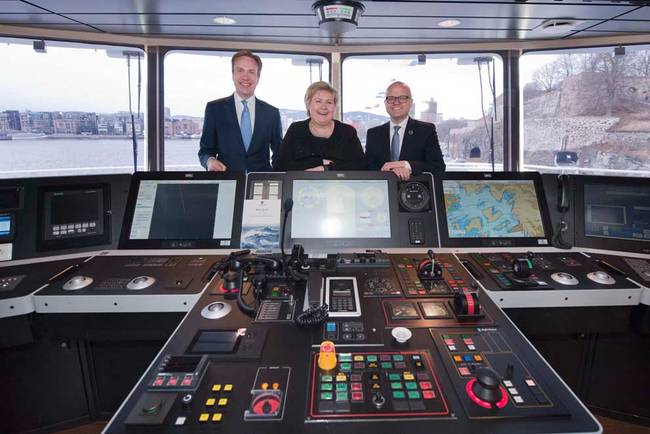We have been writing about various aspects of the Nansen programme. FAO’s Manuel Barange reflected on his experiences on the Nansen. FAO’s Kwame Koranteng explained to us how survey cruises are organized with the countries . The Institute for Marine Research of Norway (IMR)’s Kathrine Michalsen spoke about all the exciting technology aboard the new vessel. And FAO’s Peter Psomadakis spoke about the specialized training the Nansen programme offers on dry land. We’ve also written about the science seminar preceding the naming ceremony in Oslo last week and the tour of the vessel organized by the extremely knowledgeable vessel crew and IMR staff.
Finally, we’ve arrived to the big day. The naming ceremony, or christening, of the new Fridjof Nansen vessel. This 550 Norwegian kroner (60 million USD) vessel is a feat of Norwegian design and Spanish shipbuilding. The Nansen hit the water in Vigo as the most technologically advanced research vessel of its kind in the world.
Next, the Nansen navigated home: first to Bergen, Norway – the home of IMR – where it conducted sea tests, with all the impressive, new scientific equipment. As Per Nieuwejaar at IMR reported, all those tests ran smoothly. Following its time in Bergen, the vessel travelled to Oslo.
Following the morning’s conference on Friday, 24 March 2017, the naming ceremony began at noon with the arrival of Norway’s Prime Minister and Godmother to the new Nansen vessel, Ms Erna Solberg.
Prime Minister Solberg arrived at Oslo’s Akerhus Pier and greeted FAO Director-General Jose Graziano da Silva and African Ministers and Ambassadors. Speaking at the ceremony under unusually blue and sunny skies for a Norwegian March, Prime Minister Solberg noted that “with our long coastline, Norwegians have always lived surrounded by and in harmony with the sea. It’s part of our history, part of our culture. It has provided generations of Norwegians with food, employment and economic growth.”
“SDG14 – the conservation of life under water – cannot be achieved by any one country in isolation. It requires us all to do our part, and I can’t think of a better name than the one given to this research vessel dedicated to helping us achieve this task: Dr. Fridjof Nansen – a great explorer, statesman, Nobel laureate, humanitarian and scientist. Nansen had an impressive international outlook, as does this Nansen project. For over forty years, we have partnered with FAO and concentrated our efforts on building capacity in developing countries in order to improve national fisheries management and conservation of natural resources.”
Captain Stephenson of the Nansen explained to Prime Minister Solberg the complicated system for smashing a champagne bottle on such a large vessel. The Prime Minister carried out her duties admirably. The champagne bottle smashed perfectly against the new vessel – the sure sign of good luck and safe journeys for a new vessel.
The smashing of champagne was followed by a musical performance by an Oslo student choir. Next, Norway’s Minister of Foreign Affairs, Mr. Børge Brende, spoke, stressing that “This vessel is an investment in sustainable development, and specifically an investment in achieving SDG 14. For over forty years, the Nansen has supported more than sixty developing countries in developing their fisheries management. Now, with this new vessel, we want to make the Nansen even better and stronger. We are extending the programme through 2022. We are increasing the budget and welcoming other countries to join the partnership. We are proud of our long collaboration with FAO, and the fact that the Nansen flies the UN flag. We are especially pleased to have FAO’s Director-General here with us in Oslo today to celebrate this event.”
The Foreign Minister welcomed the ambitious programme’s new phase, with its new emphasis on marine pollution, microplastics and climate change – all challenges that can only be achieved through international collaboration.
Minister Brende also noted “an increased emphasis on the important role of oceans in Norway’s foreign and development policy.” He announced Norway’s first-ever white paper on strengthening the role of the Blue economy in Norway, noting its emphasis on fish as a reliable source of food, a driver for economic growth and as an activity crucial for livelihoods.
“We must ensure healthy oceans for future generations. Working together, we must stop climate change and end marine pollution. In Norway, we are convinced that the Blue Economy can be an important driver for growth in developing countries. Norway is also prioritizing the fight against illegal fishing, and in this area we are working very closely with FAO to achieve this goal. We are proud to be hosting the first inception meeting of parties to the Port State Measures Agreement in Oslo this spring.”
FAO’s Director-General Jose Graziano da Silva spoke next, thanking Norway for its generosity over its long history of collaboration with FAO on the Nansen. “I am deeply honoured and all of FAO is deeply honoured by the more than forty years of partnership on the Nansen, which is possible thanks to Norwegian support. We are extremely proud that this unique vessel flies the UN flag, and carries out its observations in some of the least observed waters on the planet. This next phase of the Nansen, with its emphasis on climate change research and a better understanding of ocean pollution, is critical as we at FAO work alongside our member countries to achieve SDG 14. And we know that our work with SDG14 will help us to achieve SDGs 1 and 2 – eradicating poverty and ending hunger. It is fitting that this vessel is named after such a great Norwegian, and a Nobel Peace Prize laureate. We firmly believe that this Nansen programme contributes to peace through international scientific collaboration.”
FAO’s Director-General went on to thank the Government and people of Norway for their generosity in supporting the work of FAO, not only with the Nansen and work related to fisheries, but in activities related to agriculture, forestry and emergencies. He also singled out the FAO Port State Measures Agreement as a key instrument to combat illegal fishing and urged countries that have not yet become a party to the agreement to do so, and thanking Norway for hosting the upcoming Port State Measures inception meeting in May.
FAO’s Director-General, Prime Minister Solberg, Foreign Minister Brende and other dignitaries took a guided tour of the vessel, with the Captain, officers, scientists and crew explaining the technology and exciting new features that make this vessel the most advanced marine research ship of its kind.
That evening, Oslo’s City Hall hosted a celebratory dinner for the Nansen christening. In the lofty atmosphere that serves as the venue for awarding the Nobel Prize for Peace, the Mayor of Oslo welcomed the participants celebrating the launch of the new vessel.
During the ceremony, FAO’s Director-General was presented with a scale model of the Nansen vessel by a representative of Astilleros Gondan shipyard, the Spanish shipbuilders that constructed the vessel designed by the Norwegian firm Skipteknisk.
The new Nansen will soon be off on new adventures – the first pot of call will be Casablanca, Morocco later this spring, before she sets off on an ambitious programme of survey voyages along the west African coast throughout 2017.
But for one day and evening, Oslo was extremely proud to have the Nansen harboured at home to celebrate this remarkable vessel. We wish the Nansen safe journeys, and will be following along on our #EAFNansen blog. We look forward to having you - virtually -on board beside us. Anchors aweigh to the new Nansen!
See this short film to learn more about the Nansen:






















